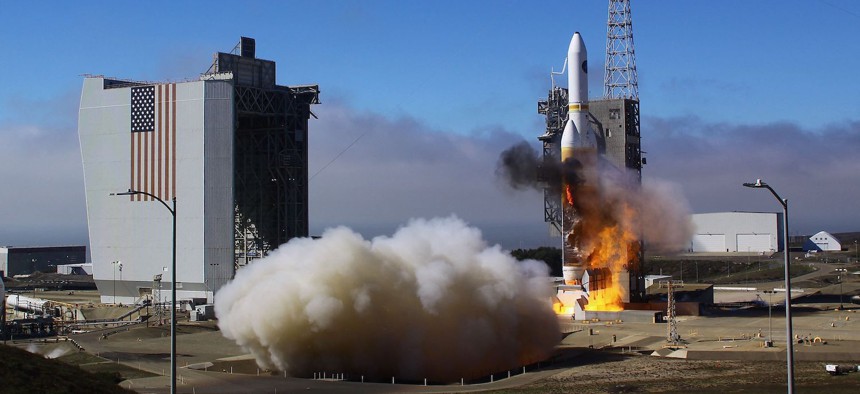
In this 2022 photo, a United Launch Alliance Delta 4 Heavy blasts off from Vandenberg Space Force Base, California as it launches a spy satellite for the National Reconnaissance Office. AFP via Getty Images / MATT HARTMAN
New spy-satellite constellation begins launch next month
Seven operational satellites are planned this year, and more through 2028, a senior NRO leader said.
COLORADO SPRINGS, Colorado—The National Reconnaissance Office will soon launch the first group of satellites to begin building the spy agency’s future network of intelligence satellites.
“We've already launched a number of demonstration satellites over the last few years to verify cost and performance….This launch will be the first launch of an actual operational system. This system will increase timeliness of access, diversity of communication pathways, and enhance our resilience,” said Troy Meink, the principal deputy director of the NRO.
The early-May launch, called NROL-146, will open the “first phase” of building the constellation and delivering operational capabilities to warfighters, Meink said Tuesday at the 2024 Space Symposium. (The agency did not provide any more details about the satellites or say how many will be in the first tranche.)
The NRO will launch six more times this year and keep launching new satellites through 2028, Meink said.
Over the next decade, he said the NRO will increase the number of satellites operating across multiple orbits, and deploy a mix of large and small satellites.
“Expanding our overhead architecture will provide greater revisit rates, increased coverage, and more timely delivery of information. This will make our collection more agile, and eliminating single points of failure will make us more resilient,” Meink said.
By expanding the NRO’s space architecture, the agency will collect more data by “an order of magnitude,” he said, and provide the Pentagon and intelligence community with crucial information.
“The NRO is developing tools and techniques to allow the community both DOD and the IC, to more effectively manage and test the architecture we're providing, so it can rapidly convert data to information,” Meink said.
Pentagon officials have been beating the drum about the importance of satellite proliferation, which would allow the U.S. to continue operations even if an adversary takes out a few of its satellites. Separately, the Space Development Agency is building out its own constellation in low-Earth orbit, called the Proliferated Warfighter Space Architecture, or PWSA, which will start delivering operational capabilities for troops this year.
The spy agency, whose operations are highly classified, is also gearing up to launch satellites to track moving vehicles and people from space, through a program called the ground moving target indicator, or GMTI. NRO officials declined to say whether the GMTI satellites are a part of the architecture Meink disclosed.
NEXT STORY: Drones, maps, and storm-tracking in the Pacific




